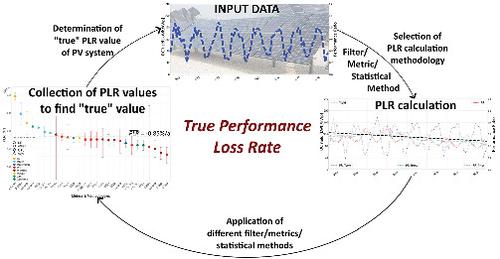当前位置:
X-MOL 学术
›
Prog. Photovoltaics
›
论文详情
Our official English website, www.x-mol.net, welcomes your
feedback! (Note: you will need to create a separate account there.)
International collaboration framework for the calculation of performance loss rates: Data quality, benchmarks, and trends (towards a uniform methodology)
Progress in Photovoltaics ( IF 8.0 ) Pub Date : 2021-03-25 , DOI: 10.1002/pip.3397 Sascha Lindig 1, 2 , David Moser 1 , Alan J. Curran 3 , Kunal Rath 3 , Arash Khalilnejad 3 , Roger H. French 3 , Magnus Herz 4 , Björn Müller 5 , George Makrides 6 , George Georghiou 6 , Andreas Livera 6 , Mauricio Richter 7 , Julián Ascencio‐Vásquez 2, 7 , Mike Iseghem 8 , Mohammed Meftah 8 , Dirk Jordan 9 , Chris Deline 9 , Wilfried Sark 10 , Joshua S. Stein 11 , Marios Theristis 11 , Bennet Meyers 12 , Franz Baumgartner 13 , Wei Luo 14
Progress in Photovoltaics ( IF 8.0 ) Pub Date : 2021-03-25 , DOI: 10.1002/pip.3397 Sascha Lindig 1, 2 , David Moser 1 , Alan J. Curran 3 , Kunal Rath 3 , Arash Khalilnejad 3 , Roger H. French 3 , Magnus Herz 4 , Björn Müller 5 , George Makrides 6 , George Georghiou 6 , Andreas Livera 6 , Mauricio Richter 7 , Julián Ascencio‐Vásquez 2, 7 , Mike Iseghem 8 , Mohammed Meftah 8 , Dirk Jordan 9 , Chris Deline 9 , Wilfried Sark 10 , Joshua S. Stein 11 , Marios Theristis 11 , Bennet Meyers 12 , Franz Baumgartner 13 , Wei Luo 14
Affiliation

|
The IEA PVPS Task 13 group, experts who focus on photovoltaic performance, operation, and reliability from several leading R&D centers, universities, and industrial companies, is developing a framework for the calculation of performance loss rates of a large number of commercial and research photovoltaic (PV) power plants and their related weather data coming across various climatic zones. The general steps to calculate the performance loss rate are (i) input data cleaning and grading; (ii) data filtering; (iii) performance metric selection, corrections, and aggregation; and finally, (iv) application of a statistical modeling method to determine the performance loss rate value. In this study, several high‐quality power and irradiance datasets have been shared, and the participants of the study were asked to calculate the performance loss rate of each individual system using their preferred methodologies. The data are used for benchmarking activities and to define capabilities and uncertainties of all the various methods. The combination of data filtering, metrics (performance ratio or power based), and statistical modeling methods are benchmarked in terms of (i) their deviation from the average value and (ii) their uncertainty, standard error, and confidence intervals. It was observed that careful data filtering is an essential foundation for reliable performance loss rate calculations. Furthermore, the selection of the calculation steps filter/metric/statistical method is highly dependent on one another, and the steps should not be assessed individually.
中文翻译:

计算绩效损失率的国际协作框架:数据质量,基准和趋势(采用统一方法)
IEA PVPS Task 13小组是来自几个领先研发中心,大学和工业公司的专注于光伏性能,运行和可靠性的专家,他们正在开发一个框架,用于计算大量商业和研究光伏的性能损失率。 (PV)发电厂及其相关的天气数据跨越不同的气候区。计算性能损失率的一般步骤是:(i)输入数据的清理和分级;(ii)数据过滤;(iii)绩效指标的选择,更正和汇总;最后,(iv)应用统计建模方法确定性能损失率值。在这项研究中,已经共享了几个高质量的功率和辐照度数据集,并要求研究的参与者使用他们偏爱的方法来计算每个单独系统的性能损失率。数据用于基准测试活动,并定义所有各种方法的功能和不确定性。数据过滤,指标(基于性能比或基于功率的指标)和统计建模方法的组合根据以下方面进行基准测试:(i)它们与平均值的偏差以及(ii)它们的不确定性,标准误差和置信区间。据观察,仔细的数据过滤是可靠的性能损失率计算的必要基础。此外,计算步骤过滤器/度量/统计方法的选择高度相互依赖,因此不应单独评估这些步骤。
更新日期:2021-04-26
中文翻译:

计算绩效损失率的国际协作框架:数据质量,基准和趋势(采用统一方法)
IEA PVPS Task 13小组是来自几个领先研发中心,大学和工业公司的专注于光伏性能,运行和可靠性的专家,他们正在开发一个框架,用于计算大量商业和研究光伏的性能损失率。 (PV)发电厂及其相关的天气数据跨越不同的气候区。计算性能损失率的一般步骤是:(i)输入数据的清理和分级;(ii)数据过滤;(iii)绩效指标的选择,更正和汇总;最后,(iv)应用统计建模方法确定性能损失率值。在这项研究中,已经共享了几个高质量的功率和辐照度数据集,并要求研究的参与者使用他们偏爱的方法来计算每个单独系统的性能损失率。数据用于基准测试活动,并定义所有各种方法的功能和不确定性。数据过滤,指标(基于性能比或基于功率的指标)和统计建模方法的组合根据以下方面进行基准测试:(i)它们与平均值的偏差以及(ii)它们的不确定性,标准误差和置信区间。据观察,仔细的数据过滤是可靠的性能损失率计算的必要基础。此外,计算步骤过滤器/度量/统计方法的选择高度相互依赖,因此不应单独评估这些步骤。









































 京公网安备 11010802027423号
京公网安备 11010802027423号